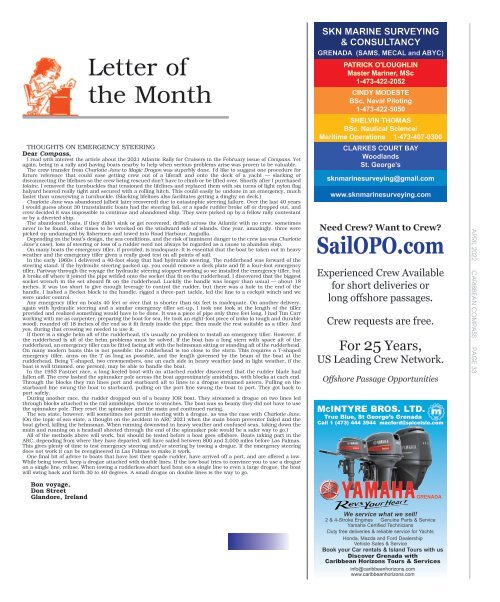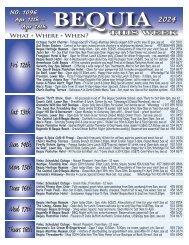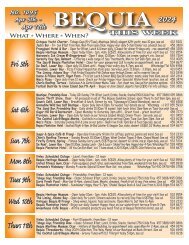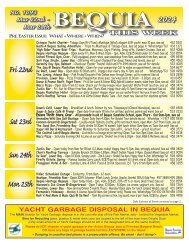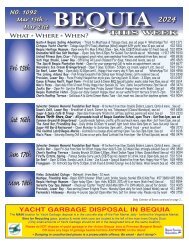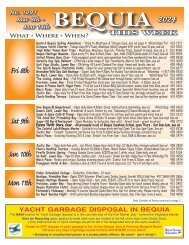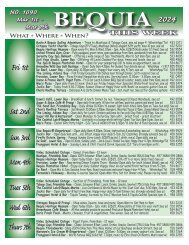Caribbean Compass Yachting Magazine - April 2022
Welcome to Caribbean Compass, the most widely-read boating publication in the Caribbean! THE MOST NEWS YOU CAN USE - feature articles on cruising destinations, regattas, environment, events...
Welcome to Caribbean Compass, the most widely-read boating publication in the Caribbean! THE MOST NEWS YOU CAN USE - feature articles on cruising destinations, regattas, environment, events...
You also want an ePaper? Increase the reach of your titles
YUMPU automatically turns print PDFs into web optimized ePapers that Google loves.
Letter of<br />
the Month<br />
THOUGHTS ON EMERGENCY STEERING<br />
Dear <strong>Compass</strong>,<br />
I read with interest the article about the 2021 Atlantic Rally for Cruisers in the February issue of <strong>Compass</strong>. Yet<br />
again, being in a rally and having boats nearby to help when serious problems arise was proven to be valuable.<br />
The crew transfer from Charlotte Jane to Magic Dragon was superbly done. I’d like to suggest one procedure for<br />
future reference that could ease getting crew out of a liferaft and onto the deck of a yacht — slacking or<br />
disconnecting the lifelines so the crew being rescued don’t have to climb or be lifted over. Shortly after I purchased<br />
Iolaire, I removed the turnbuckles that tensioned the lifelines and replaced them with six turns of light nylon flag<br />
halyard heaved really tight and secured with a rolling hitch. This could easily be undone in an emergency, much<br />
faster than unscrewing a turnbuckle. (Slacking lifelines also facilitates getting a dinghy on deck.)<br />
Charlotte Jane was abandoned (albeit later recovered) due to catastophic steering failure. Over the last 40 years<br />
I would guess about 30 transtalantic boats had the steering fail, or a spade rudder broke off or dropped out, and<br />
crew decided it was impossible to continue and abandoned ship. They were picked up by a fellow rally contestant<br />
or by a diverted ship.<br />
The abandoned boats, if they didn’t sink or get recovered, drifted across the Atlantic with no crew, sometimes<br />
never to be found, other times to be wrecked on the windward side of islands. One year, amazingly, three were<br />
picked up undamaged by fishermen and towed into Road Harbour, Anguilla.<br />
Depending on the boat’s design, the sea conditions, and the risk of imminent danger to the crew (as was Charlotte<br />
Jane’s case), loss of steering or loss of a rudder need not always be regarded as a cause to abandon ship.<br />
On many boats the emergency tiller, if provided, is inadequate. It is essential that the boat be taken out in heavy<br />
weather and the emergency tiller given a really good test on all points of sail.<br />
In the early 1960s I delivered a 40-foot sloop that had hydraulic steering. The rudderhead was forward of the<br />
steering stand. If the hydraulic steering packed up, you could remove a deck plate and fit a four-foot emergency<br />
tiller. Partway through the voyage the hydraulic steering stopped working so we installed the emergency tiller, but<br />
it broke off where it joined the pipe welded onto the socket that fit on the rudderhead. I discovered that the biggest<br />
socket wrench in the set aboard fit on the rudderhead. Luckily the handle was longer than usual — about 18<br />
inches. It was too short to give enough leverage to control the rudder, but there was a hole in the end of the<br />
handle. I lashed a Becket block to the handle, rigged a three-part tackle, led the line to a cockpit winch and we<br />
were under control.<br />
Any emergency tiller on boats 40 feet or over that is shorter than six feet is inadequate. On another delivery,<br />
again with hydraulic steering and a similar emergency tiller set-up, I took one look at the length of the tiller<br />
provided and realized something would have to be done. It was a piece of pipe only three feet long. I had Tim Carr<br />
working with me as carpenter, preparing the boat for sea. He took an eight-foot piece of iroko (a tough and durable<br />
wood), rounded off 18 inches of the end so it fit firmly inside the pipe, then made the rest suitable as a tiller. And<br />
yes, during that crossing we needed to use it.<br />
If there is a single helm aft of the rudderhead, it’s usually no problem to install an emergency tiller. However, if<br />
the rudderhead is aft of the helm problems must be solved. If the boat has a long stern with space aft of the<br />
rudderhead, an emergency tiller can be fitted facing aft with the helmsman sitting or standing aft of the rudderhead.<br />
On many modern boats this is not possible: the rudderhead is too close to the stern. This requires a T-shaped<br />
emergency tiller, arms on the T as long as possible, and the length governed by the beam of the boat at the<br />
rudderhead. Being T-shaped, two crewmembers, one on each side in heavy weather (and in light weather, if the<br />
boat is well trimmed, one person), may be able to handle the boat.<br />
In the 1953 Fastnet race, a long-keeled boat with an attached rudder discovered that the rudder blade had<br />
fallen off. The crew lashed the spinnaker pole across the boat approximately amidships, with blocks at each end.<br />
Through the blocks they ran lines port and starboard aft to lines to a drogue streamed astern. Pulling on the<br />
starboard line swung the boat to starboard, pulling on the port line swung the boat to port. They got back to<br />
port safely.<br />
During another race, the rudder dropped out of a beamy IOR boat. They streamed a drogue on two lines led<br />
through blocks attached to the rail amidships, thence to winches. The boat was so beamy they did not have to use<br />
the spinnaker pole. They reset the spinnaker and the main and continued racing.<br />
The sea state, however, will sometimes not permit steering with a drogue, as was the case with Charlotte Jane.<br />
(On the topic of sea state, a thought on the accident in ARC 2021 when the main boom preventer failed and the<br />
boat gybed, killing the helmsman. When running downwind in heavy weather and confused seas, taking down the<br />
main and running on a headsail sheeted through the end of the spinnaker pole would be a safer way to go.)<br />
All of the methods above will work, but should be tested before a boat goes offshore. Boats taking part in the<br />
ARC, depending from where they have departed, will have sailed between 800 and 2,000 miles before Las Palmas.<br />
This gives plenty of time to test emergency steering and/or steering by towing a drogue. If the emergency steering<br />
does not work it can be reengineered in Las Palmas to make it work.<br />
One final bit of advice to boats that have lost their spade rudder, have arrived off a port, and are offered a tow.<br />
While being towed, keep a drogue attached with double lines. If the tow boat tries to convince you to use a drogue<br />
on a single line, refuse. When towing a rudderless short keel boat on a single line to even a large drogue, the boat<br />
will swing back and forth 30 to 40 degrees. A small drogue on double lines is the way to go.<br />
SKN MARINE SURVEYING<br />
& CONSULTANCY<br />
GRENADA (SAMS, MECAL and ABYC)<br />
PATRICK O'LOUGHLIN<br />
Master Mariner, MSc<br />
1-473-422-2052<br />
CINDY MODESTE<br />
BSc, Naval Piloting<br />
1-473-422-5050<br />
SHELVIN THOMAS<br />
BSc. Nautical Science/<br />
Maritime Operations 1-473-407-0300<br />
CLARKES COURT BAY<br />
Woodlands<br />
St. George’s<br />
sknmarinesurveying@gmail.com<br />
www.sknmarinesurveying.com<br />
Need Crew? Want to Crew?<br />
SailOPO.com<br />
Experienced Crew Available<br />
for short deliveries or<br />
long offshore passages.<br />
Crew requests are free.<br />
For 25 Years,<br />
US Leading Crew Network.<br />
Offshore Passage Opportunities<br />
McINTYRE BROS. LTD.<br />
True Blue, St George’s Grenada<br />
Call 1 (473) 444 3944 macford@spiceisle.com<br />
APRIL <strong>2022</strong> CARIBBEAN COMPASS PAGE 33<br />
Bon voyage,<br />
Don Street<br />
Glandore, Ireland<br />
GRENADA<br />
We service what we sell!<br />
2 & 4-Stroke Engines Genuine Parts & Service<br />
Yamaha Certified Technicians<br />
Duty free deliveries & reliable service for Yachts<br />
Honda, Mazda and Ford Dealership<br />
Vehicle Sales & Service<br />
Book your Car rentals & Island Tours with us<br />
Discover Grenada with<br />
<strong>Caribbean</strong> Horizons Tours & Services<br />
info@caribbeanhorizons.com<br />
www.caribbeanhorizons.com


